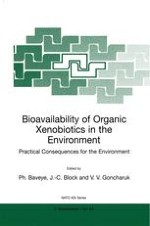1999 | OriginalPaper | Chapter
Bioremediation of Environments Contaminated with Organic Xenobiotics: Putting Microbial Metabolism to Work
What happens with the contaminant once it has reached the cell surface?
Author : A. J. B. Zehnder
Published in: Bioavailability of Organic Xenobiotics in the Environment
Publisher: Springer Netherlands
Included in: Professional Book Archive
Activate our intelligent search to find suitable subject content or patents.
Select sections of text to find matching patents with Artificial Intelligence. powered by
Select sections of text to find additional relevant content using AI-assisted search. powered by
Microorganisms can metabolize many aliphatic and aromatic contaminants, either to obtain carbon and/or energy for growth, or as co-substrates, thus converting them into carbon dioxide, water, chloride and biomass. To be able to exploit these biotransformations for the remediation of contaminated environments, a number of prerequisites have to be fulfilled. The chemical has first to reach the microbial cell, then it must be transported into the cell. Toxicity should be absent or limited at the in situ concentration the cell is exposed to. This chapter reviews a number of metabolic reactions that convert the contaminant into common intermediary metabolites.
